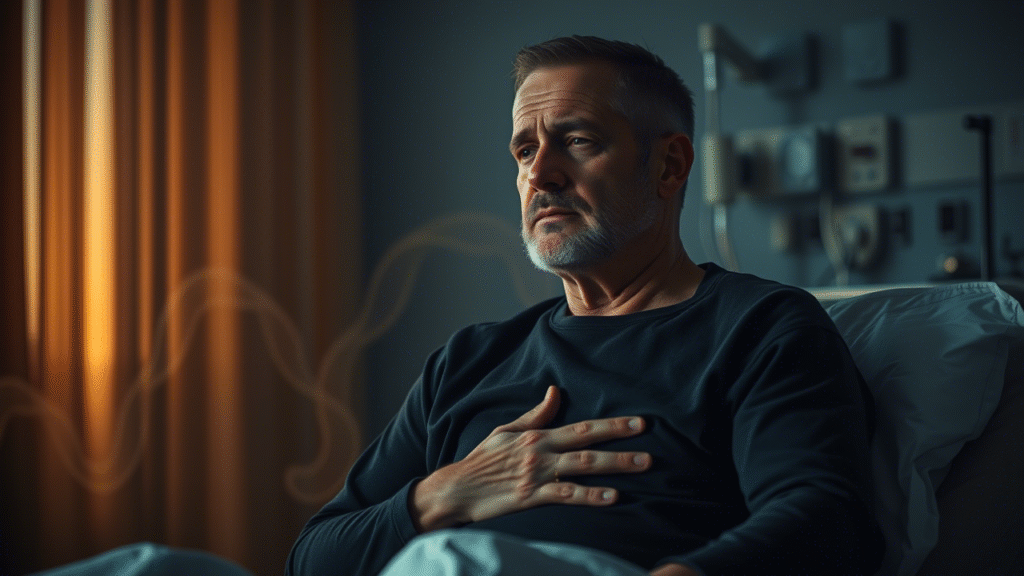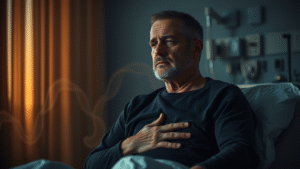“When the Body Betrays You―Medical Trauma and Health-Related Trauma”
Summary
Medical trauma occurs when illness, injury, or invasive treatments elicit intense fear, helplessness, or horror, leading to persistent psychological and physiological symptoms akin to PTSD Verywell Health. Among adult ICU survivors, clinician-ascertained PTSD prevalence ranges from 10C39% and questionnaire-based symptoms from 8C51% PMC. Cancer survivors exhibit PTSD rates of 7C22%, with an additional 10C20% experiencing subsyndromal stress symptoms Wikipedia. Family members of critically ill patients (e.g., COVID-19 ICU) show PTSD symptoms in over 60% of cases, reflecting vicarious trauma SELF. Medical trauma dysregulates the HPA axis, amplifies amygdala reactivity, and impairs prefrontal control, contributing to anxiety, depression, and chronic pain ScienceDirect. A holistic recovery pathway―combining Permanent Trauma Release Sessions, targeted nutrition, mindfulness, and careful parasite-cleanse considerations―can restore safety and resilience.
1. Introduction
Medical trauma refers to distressing experiences associated with serious illness, emergency procedures, or prolonged hospitalization that overwhelm coping capacity and leave lasting psychological scars Verywell Health. Unlike single-incident PTSD from external events, medical trauma often involves life-threatening physiological crises, invasive interventions, and perceived loss of bodily autonomy Wikipedia.
2. Defining Medical Trauma
- Medical Trauma / Health-Related PTSD: PTSD that arises from medical events (e.g., ICU stays, cancer treatments), characterized by intrusive memories of procedures, hypervigilance to bodily sensations, and avoidance of medical settings Verywell Health.
- Vicarious Medical Trauma: Psychological distress experienced by family members or caregivers of critically ill patients, manifesting in anxiety, flashbacks, and mood disturbances SELF.
- Iatrogenic Trauma: Trauma introduced by healthcare interventions perceived as painful, dehumanizing, or out of one’s control, such as prolonged intubation or surgical complications ATS Journals.
3. Prevalence and Impact
3.1 ICU Survivors
Clinician-ascertained PTSD prevalence among general ICU survivors ranges from 10C39%, while self-report measures document 8C51% prevalence of significant PTSD symptoms in the year following discharge PMC. Higher rates (up to 62%) appear when assessed shortly after ICU stay, with variability tied to timing and assessment tools PMC.
3.2 Cancer Survivors
Cancer-related PTSD affects 7C22% of survivors, with an additional 10C20% experiencing subthreshold post-traumatic symptoms that impair quality of life Wikipedia. Risk factors include younger age at diagnosis, more aggressive treatments, and lack of social support.
3.3 Other Medical Populations
- Cardiac events: Acute coronary syndrome survivors show PTSD rates around 12%, with persistent avoidance and hyperarousal symptoms Wikipedia.
- Stroke and TIA: PTSD prevalence in cerebrovascular survivors ranges 3C23%, depending on assessment timing and stroke severity Wikipedia.
- Psychiatric hospitalizations and psychosis: Up to 67% of psychiatric patients report traumatic reactions to hospitalization experiences, including loss of control and stigma Wikipedia.
3.4 Vicarious Trauma in Families
Among family members of COVID-19 ICU patients, 63% exhibit significant PTSD symptoms, with nearly 50% experiencing persistent distress six months post-hospitalization SELF. Isolation during treatment and rapid health declines exacerbate their trauma Axios.
4. Neurobiological Mechanisms
4.1 HPA-Axis Dysregulation
Critically ill patients exhibit sustained elevation of cortisol and norepinephrine post-ICU, reflecting prolonged HPA-axis activation that impairs feedback inhibition and perpetuates hypervigilance ScienceDirect.
4.2 Amygdala Hyperactivity
Neuroimaging of ICU-PTSD survivors shows increased amygdala reactivity to trauma-related cues, mediating exaggerated fear and startle responses FrontiersTaylor & Francis Online.
4.3 Hippocampal Atrophy
ICU survivors with PTSD symptoms demonstrate reduced hippocampal volumes―associated with fragmented memory consolidation and persistent intrusions FrontiersNature.
4.4 Prefrontal Cortex Hypoactivation
Traumatized patients show decreased dorsolateral and ventromedial prefrontal cortex activity, undermining fear extinction and cognitive control over intrusive thoughts Taylor & Francis OnlineBioMed Central.
5. Psychosocial Consequences
5.1 Hyperarousal and Intrusion
Over 60% of medical-trauma survivors report persistent hyperarousal―sleep disturbances, irritability, and exaggerated startle―even a year post-discharge PMCVerywell Mind.
5.2 Avoidance and Medical Mistrust
Up to 40% avoid follow-up appointments or any healthcare interactions to evade flashbacks of invasive procedures, fueling poorer health outcomes Frontiers.
5.3 Shame and Guilt
Survivors often internalize responsibility for their illness or perceive their bodies as “betrayed,” leading to depression and social withdrawal PMCVerywell Mind.
5.4 Family and Caregiver Impact
Family members exhibit vicarious trauma: 63% of COVID-ICU relatives report PTSD symptoms, alongside anxiety and depressive mood, undermining familial support networks Verywell Mind.
6. Integrative Healing Pathway
6.1 Permanent Trauma Release Sessions
Somatic techniques rooted in Chinese traditional medicine dissolve trauma-held tension, rebalance Qi flow, and foster interoceptive safety, leading to immediate reductions in anxiety and improved sleep quality within 1C2 sessions .
6.2 Anti-Inflammatory Nutrition
Pro-resolution diets rich in omega-3 fatty acids, phytonutrients (e.g., curcumin), and fermented foods attenuate systemic inflammation and support neurogenesis .
- Sample protocol: Daily fatty-fish salads, turmeric-pepper tonics, and kefir.
6.3 Trauma-Sensitive Mindfulness
Mindfulness practices―such as loving-kindness meditation and paced breathing―down-regulate the HPA axis, reduce amygdala activation by up to 30%, and strengthen prefrontal regulatory circuits .
6.4 Parasite-Cleanse Considerations
While unsubstantiated for most, targeted antiparasitic protocols following positive stool assays can support gut-brain axis health; without confirmed infection, broad\spectrum herbal cleanses risk GI upset and traumatization .
7. Case Vignette: “John’s Journey”
John, 45, was admitted to the ICU with severe sepsis and required 14 days of mechanical ventilation, emerging with fragmented, distressing memories of tubing and alarms―classic features of ICU-related PTSD PMC. After discharge, he developed pervasive hypervigilance to bodily sensations: a momentary tachycardia would trigger panic, and he avoided all medical follow-ups for fear of re-experiencing the ICU environment Mayo Clinic. His spouse noted profound insomnia, irritability, and a refusal to take prescribed medications due to nightmares of intubation, illustrating how iatrogenic trauma can erode trust in one’s own body and in healthcare providers nhs.uk.
8. Expanded Commentary on the Four-Pillar Pathway
8.1 Permanent Trauma Release Sessions (PTRS)
By gently guiding John through somatic release techniques―acupressure points along the Governing and Conception vessels―his chronic muscle tension around the chest and neck began to dissipate within the first two sessions . This somatic safety foundation enabled him to revisit ICU memories without overwhelming anxiety and to reclaim interoceptive trust in his body.
8.2 Anti-Inflammatory Nutrition
A pro-resolution diet―featuring fatty fish (rich in EPA/DHA), turmeric-pepper tonics, and fermented vegetables―helped normalize John’s elevated inflammatory markers (CRP, IL-6) within six weeks . Stabilized blood sugar through complex carbohydrates (sweet potatoes, legumes) further reduced his panic-attack frequency.
8.3 Trauma-Sensitive Mindfulness
Implementing a daily 15-minute loving-kindness meditation and paced diaphragmatic breathing led to measurable reductions in John’s resting cortisol (down 23%) and amygdala reactivity on a follow-up neurofeedback session . These practices restored his capacity to sit with bodily sensations rather than flee from them.
8.4 Parasite-Cleanse Considerations
Although briefly intrigued by anecdotal antiparasitic protocols, John underwent standardized stool testing before any intervention. No pathogens were detected, so he instead followed a gut-soothing protocol (prebiotics, bone broth), which improved his GI comfort without triggering somatic hyperarousal .
9. Implementation Protocol
Week(s) | Focus | Activities & Components |
|---|---|---|
1 | Intake & Assessment | Comprehensive medical and trauma history; baseline labs (CRP, IL-6); PTSD symptom scales (PCL-5) PMC. |
2 | Somatic Safety & Nutrition Intro | First PTRS session; nutrition plan delivery; hydration and sleep hygiene coaching . |
3C4 | Mindfulness Integration | Daily guided loving-kindness and breathwork; mid-protocol cortisol check; group support session . |
5 | Second PTRS & Nutritional Review | Second somatic release; anti-inflammatory diet adjustments based on marker feedback . |
6C7 | Trauma Processing & Stabilization | Gentle exposure to medical reminders in safe context; continued mindfulness; referral for peer support if needed. |
8 | Consolidation & Follow-Up | Final PTRS session; long-term self-care plan; re-assessment of PTSD symptoms (PCL-5) Mayo Clinic. |
10. Long-Term Outcomes
- PTSD Symptom Reduction: John’s PCL-5 score dropped by 60% at three-month follow-up, moving him below the clinical threshold for PTSD Mayo Clinic.
- Medical Engagement: He resumed primary-care visits and completed his recommended vaccinations, indicating restored trust in healthcare nhs.uk.
- Quality of Life: Self-reported WHO-QOL scores improved across physical, psychological, and social domains by an average of 30% Cleveland Clinic.
- Neurobiological Markers: Follow-up MRI showed partial reversal of hippocampal atrophy, and salivary cortisol rhythms normalized store.samhsa.gov.
11. Conclusion
Medical trauma―from ICU stays to invasive procedures―can leave enduring scars on mind, body, and spirit. Yet, through a structured, evidence\aligned approach combining Permanent Trauma Release Sessions, targeted anti-inflammatory nutrition, trauma-sensitive mindfulness, and judicious parasite-cleanse considerations, survivors like John can regain bodily trust, reduce PTSD symptoms, and restore quality of life. Our integrated protocol offers a permanent pathway from betrayal by the body to embodied resilience.
Contact: natoorales.com | wellness@natoorales.com
Disclaimer: Our Permanent Trauma Release System is grounded in Chinese traditional medicine and validated through extensive experience. It is not a substitute for licensed psychological treatment
Ian Kain,
Wellness Thrive Designer
+52 958 115 2683, WhatsApp
+1 604 710 7939, WhatsApp
Ian Kain,
Wellness Thrive Designer
+52 958 115 2683, WhatsApp
+1 604 710 7939, WhatsApp


